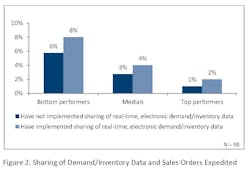APQC’s data hints at a disconnect between the adoption of information visibility practices and the actual use of the information. The adoption of real-time information sharing is intended to give organizations a better idea of what products customers will be ordering so that they can meet customer needs. However, the information is only as good as the actions it spurs organizations to take. If an organization does not use the information available or if it uses the information but takes no steps to improve poor logistics processes, the organization will see logistics performance stagnate or suffer.
Information as a Starting Point
Having access to real-time data regarding demand and inventory levels can give an organization the ability to better meet customer needs. However, simply having the information available is not enough. In order for information visibility to have value, organizations must make sure their logistics processes are efficient and the information is strategically leveraged. APQC’s data indicates that many organizations have taken the step to gain access to real-time data, but these organizations have not fully realized the benefits possible from this practice.
Organizations seeking to gain access to real-time, electronic demand and inventory data should not let the logistics performance of other organizations deter them. Instead, organizations should ensure that they have efficient logistics processes and strategies for how information is used. Having these items in place will allow organizations to experience the full benefits of supply chain visibility.
APQC is a member-based nonprofit and a proponent of benchmarking and best practice business research. Working with more than 500 organizations worldwide in all industries, APQC focuses on providing organizations with the information they need to work smarter, faster and with confidence.
Related Articles:
Supply Chain Metrics: Improve Supply Chain Planning with S&OP
Inventory Accuracy Improves Performance on Logistics Metrics
Lean Procurement Processes Mean Fewer Employees






